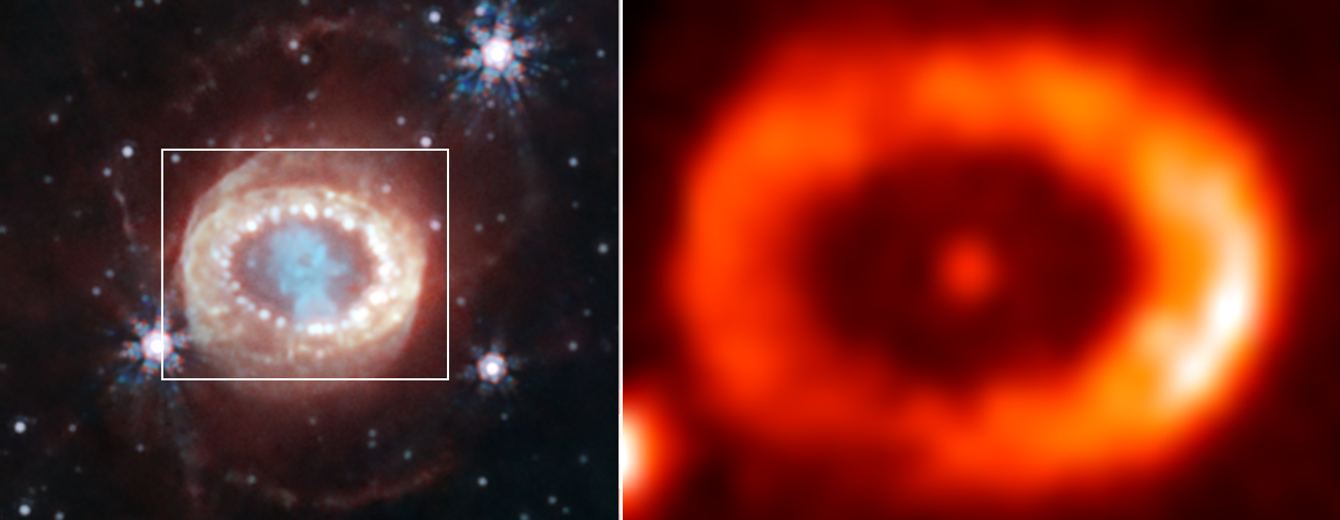I can remember seeing images of SN1987A as it developed back in 1987. It was the explosion of a star, a supernova in the Large Magellanic Cloud. Over the decades that followed, it was closely monitored in particular the expanding debris cloud. Predictions suggested there may be a neutron star or even a black hole at the core but the resolution of the telescopes was insufficient to pick anything up. Now we have the James Webb Space Telescope and using its more powerful technology, signs of a neutron star have been detected.
Supernova are among the most spectacular and intense explosions in the Universe that signal the end of a massive star’s life. They emit vast amounts of energy and radiation and at the moment of explosion, their light can exceed that of all the stars in the host galaxy put together. There are the type II supernova and it is this type of phenomenon that brought 1987A to our skies.
1987A occurred in the Large Magellanic Cloud which is approximately 160,000 light years away and was first observed in February 1987. It continued to brighten until its luminosity peaked three months later in May. It even became visible to the naked eye, the first since Kepler’s Supernova of 1604. Before the visible light signals were detected, three observatories detected short bursts of neutrinos. The bursts were attributed to the supernova and they gave insight into the events leading up to the collapse. Since the event, astronomers have been searching for its existence.
Acknowledgment: Image processing: Travis Rector (University of Alaska Anchorage), Mahdi Zamani & Davide de Martin
Observations of similar objects, like the supernova remnant in Taurus, the Crab Nebula , revealed a neutron star at the core of the debris field. In the years that followed astronomers hunted for evidence but no direct evidence had been found.
The James Webb Space Telescope was focussed onto the 1987A remnant in July 2022, making it one of the earliest objects observed by Webb. The team used the Medium Resolution Spectrograph (MRS) mode of the Mid-Infrared instrument (MIRI). It was a tool that had been partly developed by the team that were hunting for the 1987A neutron star. MIRI was a wonderful tool that could simultaneously image an object whilst it was obtaining its spectrum! This allowed observers the ability to detect spectroscopic variations across the object while analysing the Doppler shift at various points to assess velocity at each position.

The team found a strong signal due to ionised argon that seemed to originate from a region around the site of the original 1987A event. Using Webb’s Near-Infrared Spectrograph (NIRSpec) they observed shorter wavelengths and detected even more ionised elements including five times ionised argon (this mean the argon atoms have lost five of their eighteen electrons). For these to be created, they required highly energetic photons and these had to come from somewhere.
The conclusion is that their must be some source of high-energy radiation in the centre of the 1987A remnant. Of all the options discussed in their paper, lead author Claes Fransson of Stockholm University hints that only a few of the scenarios are likely but they all involve a young energetic neutron star. More observations are now required to follow up on this and probe the heart of the 1987A supernova remnant to see if the neutron star can finally be visually identified.
Source : Webb Finds Evidence for Neutron Star at Heart of Young Supernova Remnant

Dr. Thomas Hughes is a UK-based scientist and science communicator who makes complex topics accessible to readers. His articles explore breakthroughs in various scientific disciplines, from space exploration to cutting-edge research.








